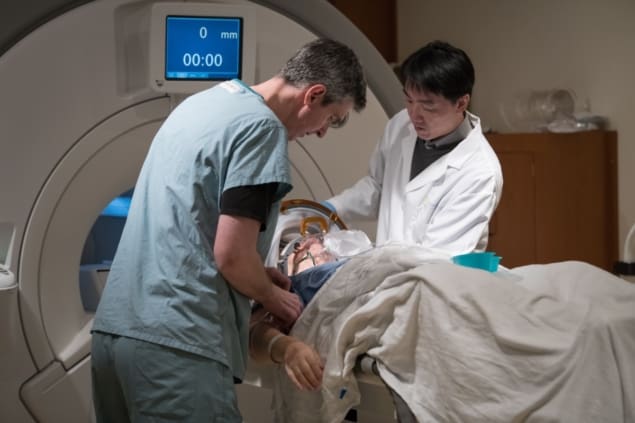
MR-guided focused ultrasound (MRgFUS) is a novel surgical technique that can be used for incision-free ablative neurosurgery. Two Phase I clinical trials conducted at Sunnybrook Research Institute have demonstrated that MRgFUS appears to be safe and effective for patients with treatment-resistant obsessive compulsive disorders (OCD) and major depressive disorder (MDD). Of 12 study participants who underwent MRgFUS bilateral anterior capsulotomy, half reported an improvement in their quality-of-life.
Anterior capsulotomy, an established neurosurgical procedure, creates a lesion in a brain pathway known to be involved in OCD and MDD. This region, the anterior limb of the internal capsule (ALIC), connects key areas of the brain involved in anxiety and regulation of emotions. The lesion, which is usually created using radiofrequency (RF) ablation or stereotactic radiosurgery (SRS), interrupts the ALIC fibres to help reset abnormal communication in the brain.
Treatment with MRgFUS does not require the invasive surgery needed for RF ablation, and does not expose a patient to the high radiation doses of SRS. Performed inside an MRI scanner, MRgFUS uses MR imaging to guide multiple high-powered ultrasound beams to a small target, to achieve controlled heating and ablation.
For the procedure, patients wore a helmet fixed over a rigid headframe. The helmet contains 1024 ultrasound elements that target brain regions with millimetre accuracy. The team performed three low-powered test sonications, which raised the temperature of the targeted region to 40–45°C, to align the sonication focus and confirm targeting accuracy. They then performed higher powered sonications to raise temperatures to over 53°C and create lesions. These were repeated based on the temperature rise, estimated thermal dosing and patient tolerance. They used T2-weighted MRI and real-time thermography to confirm the accuracy of the lesion targeting.
The treatments, performed at Sunnybrook Health Sciences Center, took three to four hours. The researchers treated 16 patients in total, but the procedure was not successful for four of them due to insufficient MRgFUS heating at the target site.
Writing in Molecular Psychiatry, the researchers report interim six-month post-treatment findings from their 12 month trial. They found that patients with OCD responded better to MRgFUS capsulotomy than those with MDD, with 66% and 33% of patients, respectively, achieving a significant treatment response.
None of the patients experienced any serious treatment-related adverse effects, reports principal investigator Nir Lipsman, director of Sunnybrook’s Harquail Centre for Neuromodulation. Seven patients reported swelling at the site of the headframe pins and headaches for several days, and one patient experienced mild headaches for several months.
Four of the six OCD patients experienced a more than 35% reduction in their Yale-Brown Obsessive Compulsive Scale (YBOCS), and two patients with MDD had a greater than 50% reduction in their Hamilton Depression Rating Scale (HAMD17). Improvements in YBOCS and HAMD17 scores also were generally accompanied by measurable improvements in mood, anxiety and quality-of-life. No negative cognitive or behavioural effects were experienced by nine patients who underwent neuropsychological testing.
The studies also showed that MRgFUS capsulotomy lesions led to significant metabolic and functional alterations in brain circuits governing affective processing, and that pre-operative functional connectivity – measured using resting-state functional MRI – could differentiate treatment responders from non-responders.
“These findings suggest that a focal lesion in bilateral ALIC can have widespread effects on glucose utilization, supporting the notion that OCD and depression are indeed circuit conditions in the brain, and that influencing key nodes in that circuit can have brain-wide effects,” comments Lipsman.

Focused ultrasound opens the blood-brain barrier
“Our study supports the importance of continued research into focused ultrasound as a safe and innovative treatment approach for patients with difficult to treat OCD and depression,” he adds. “Patients with these debilitating neuropsychiatric conditions have tried conventional treatments without success and are in need of novel treatment options.”
Lipsman tells Physics World that following these initial trials, the next steps will be to expand to larger patient populations and more comprehensively study both the safety and efficacy of MRgFUS in treatment-resistant psychiatric disorders. “More patients, in more centres, and with comprehensive study of responses prior to and after treatment will help inform what role MRgFUS may play in the care of these patients,” he says.



